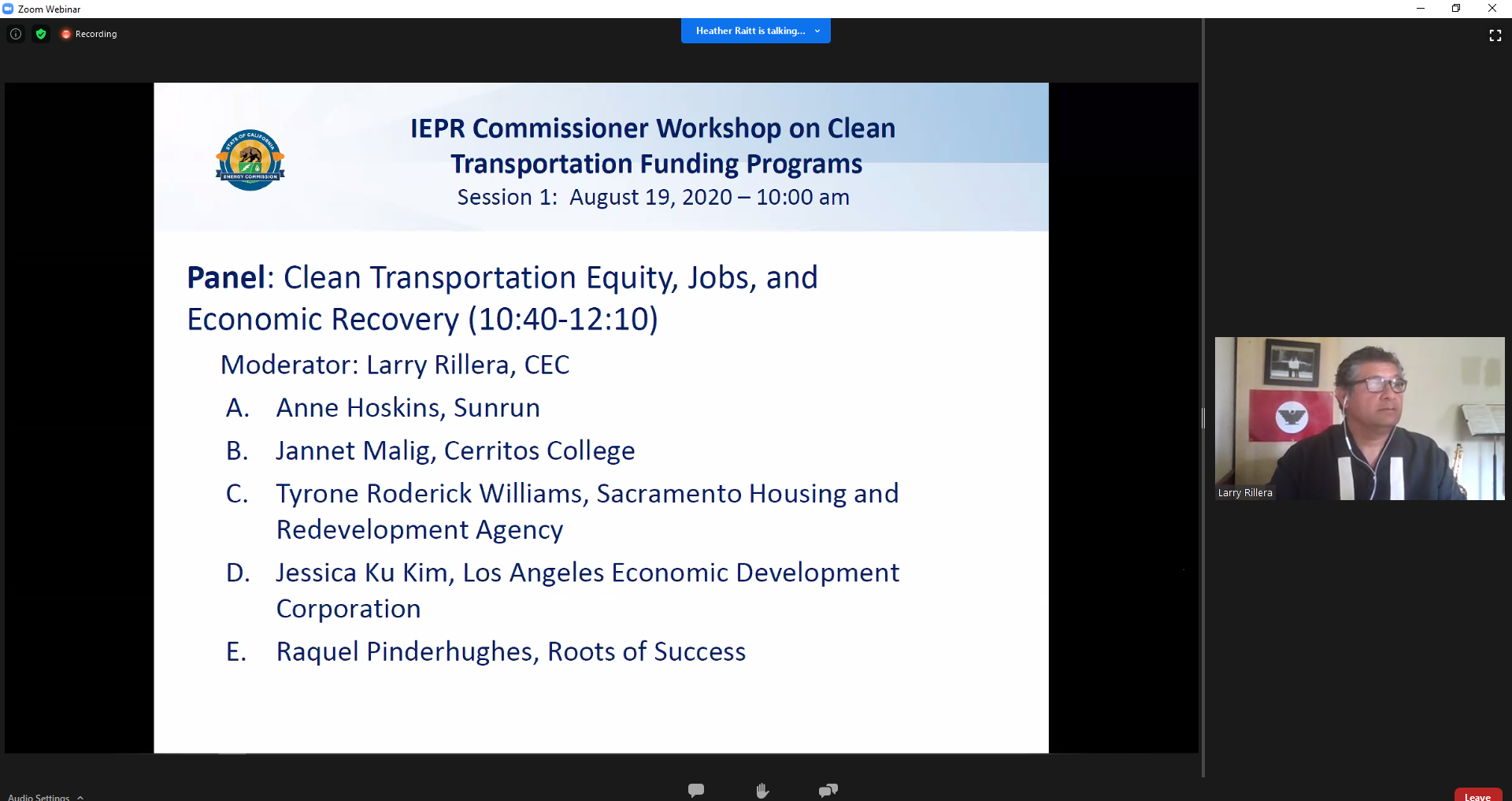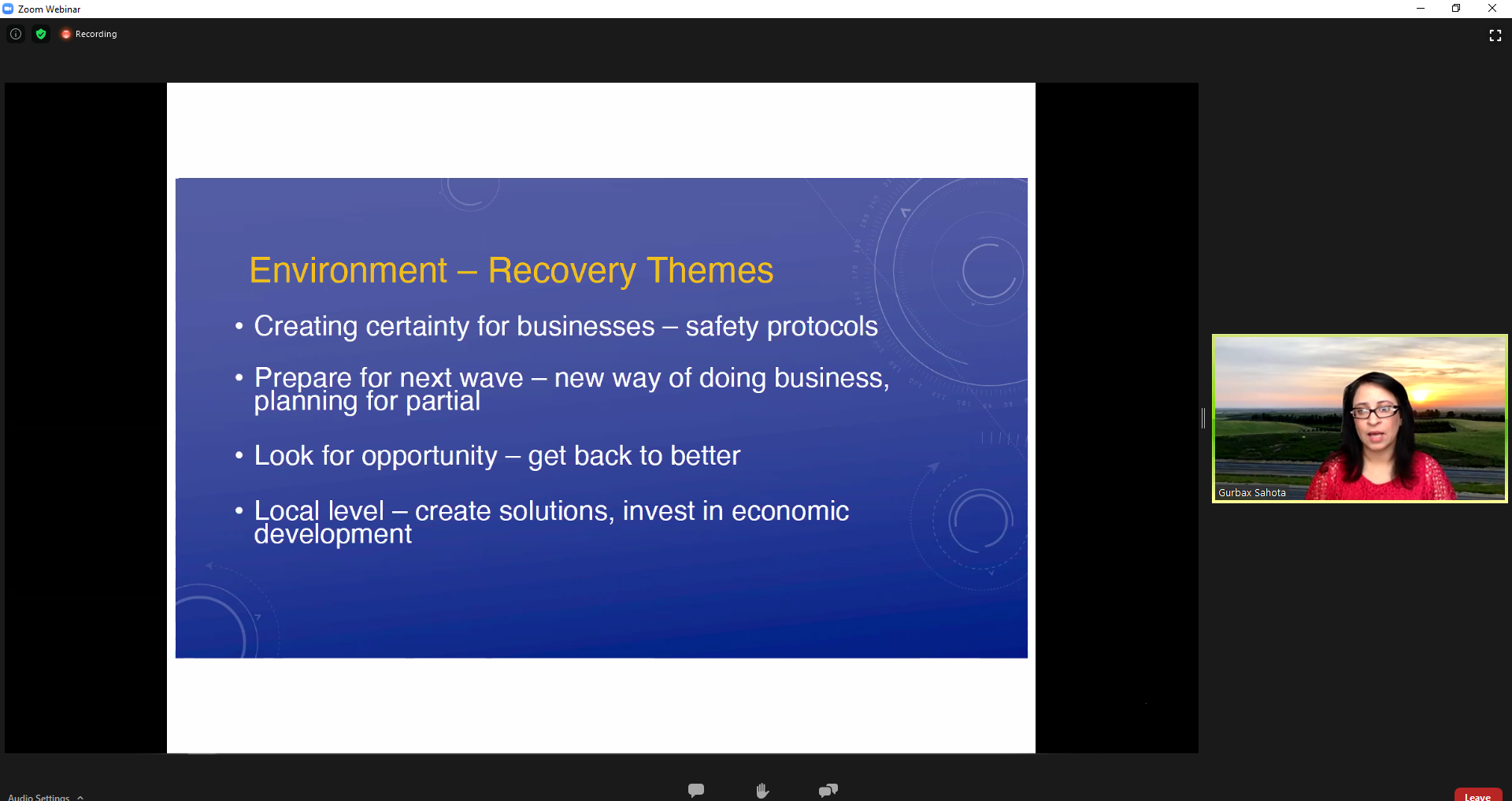
LAEDC’s Jessica Ku Kim spoke at the California Energy Commission (CEC) Workshop meeting (webinar) on August 19th on the topic of economic recovery related to the California clean transportation industry. You wouldn’t be faulted for being too busy to join another zoom meeting, so here is a recap of the key points from the meeting. Coincidentally, during this webinar, news was spreading of two LA-based EV companies making big funding and expansion announcements. Serendipity.
To learn more about the Electric Vehicle Industry in LA County, visit LAEDC’s recent research report, The Electric Mobility Revolution.

The meeting centered around the role of economic development in creating good jobs in California’s EV industry, and making sure that disadvantaged communities which are facing high unemployment benefit substantially, as we all collectively gain a strong and more sustainable economy.
Gurbax Sahota, President and CEO of CALED started off the meeting by sharing great observations. “Economic Development is the creation of wealth through which community benefits are realized.”
She emphasized the need to keep government programs rolling, even though there is a budget-minded desire to cut government spending in the pandemic. “You can’t cut your way to prosperity.” She also said that in economic development, “We are first responders for businesses. We are the boots on the ground to help those businesses, and recovery happens one business at a time.”
She reminded us that the intention of economic development is to improve quality of life, the future we want, the prosperity we desire.

“Bringing manufacturing back to California is a big opportunity,” she said, because it helps equity and disadvantaged people. “Manufacturing has been the key to CA’s success. For every one manufacturing job created, there were 2.5 more jobs created in the regional economy, so the multiplier effect of investing in manufacturing is important. And if you don’t have a higher education degree, there are pathways into manufacturing.”
The point was also made that the CEC has $100M/yr of funding which can be used to promote equity, jobs and recovery.
With that, moderator and host Larry Rillera, from the CEC (who supports ZEV Manufacturing/Workforce/Equity) introduced the panelists and they offered thoughts:
Jessica Ku Kim, Senior Director of Workforce Development at LAEDC said we should support EV incentives for low income families. In addition, we should, “Grow jobs by using our own local government buying power. We have 60 EV manufacturers in CA and we need to support these companies, including by expanding demand.”

Jessica continued, “These are family supporting jobs. We don’t want to wait for Californians to be displaced from their jobs and then work to reskill them. We need to get ahead of the curve. We need to start younger on workforce development, to make sure the STEM skills needed in this industry start early.” She said that we need broader community buy-in, and we don’t want diversity as an end thought, we want to think about it ahead of time. This will be an industry that continues to change, so lifelong learning will be important. She advocated for focus on developing an understanding of the cross disciplinary skills, and training to work in teams and rethink and redo. She also pointed out there are about 20 automotive design firms in LA, along with a cluster of EV OEMs and related tech companies, making the region a creative nexus with expertise in EVs and concepts of the future. “We need to disseminate the program information, so it gets down to the neighborhood level where it needs to be. We want the research here, we want the design here, we want the manufacturing here. We want to ensure that the whole market is here, so California companies are leading and are supported by the whole ecosystem. We shouldn’t just look at manufacturing as the job creator.”
Jannet Malig, Advanced Transportation Director for CA Community Colleges said that there are so many barriers to entry in disadvantaged communities. “We need to let them know about the opportunity in clean transportation.” She mentioned it is a lifelong learning process that includes training, retraining and upskilling for the current workforce. “We know the skillsets that were entry level a year ago are not always enough today.” Retraining and reskilling also allows workers to move between sectors. She talked about the importance of opening up awareness in communities. “We realize there is a lot of opportunity for OEMs to promote these technologies in the communities, so middle school and high schoolers in disadvantaged communities can see these opportunities, and our Community Colleges are there to support that pathway once these interests are fostered.” “At the Community College level we want to show there are great opportunities and job mobility – a lot of students are getting picked up before they even finish our green/clean transportation programs.” She reminded industry viewers that promoting your companies showcases the upward mobility to students and potential job seekers. She concluded by saying community awareness of programs is essential. Jannet offered the following link for those interested in the community college programs that help you gain a career in LA’s electric vehicle industry: https://atleducation.org/ . EV industry companies are also encouraged to contact her to create talent pipelines as your business grows.
Anne Hoskins of Sunrun said that Sunrun has been fortunate to help the state with the energy supply this week. She talked about the importance of incentives, which were foundational in getting the sustainability industries off the ground. In the electricity market, “Net Metering as a foundational regulatory role is key…and that policy is about to be reviewed again.” She said it’s important to keep this as simple as possible, with consistency over time. “Already, they are looking at changing the time-of-use rates aspect of Net Metering. We need to be really careful about changing policies that are foundational.”
She also discussed the SGIP program, which has incentivized the market for batteries, prioritizing low income residents including those in fire-threatened neighborhoods. “We need to expedite those budgets.” She said the company supports Storage on Multifamily Affordable Housing (SOMAH) because it is important to see solar helping all families. “We need to think about making a market, a range of customers who can participate, which will drive down costs of solar batteries and EVs. Expand access and get the mass market engaged.” She also said we need to expedite and automate permitting, such as with NREL Solar App, ( a free tool for permitting for municipalities to use) which would automate the whole process, save money for municipalities, and get the projects through a lot faster. “It is taking 30 days to get projects permitted in many places. Let’s make this easier, let’s meet our climate goals. We could expand access to batteries for more people if we want to. We don’t have to keep coming up with something new…we just need to help people understand what is out there. Especially for those people in disadvantaged communities. Let’s double down on what is currently available and working.” In support of automated permitting, she pointed out that In Germany the cost of installing storage is 30% less due to soft costs.
Tyrone Roderick Williams, Sacramento Housing and Redevelopment Agency observed that unemployment is a huge challenge right now, as people are at home waiting for their businesses to reopen. Some of them will never reopen again and those jobs are gone. “People are struggling with how to put their lives together. The CEC can change this.” Sacramento is first housing authority in nation to talk about providing cars and housing for residents, with electric cars and charging stations. “We need to do a whole lot of training for people whose jobs no longer exist.”
Dr. Raquel Pinderhughes, Roots of Success, an expert on sustainable development and environmental justice talked about the importance of pathways out of poverty and giving justice-involved people opportunities. She said that we need to reach out to people who have been failed by the education system, we need to help these people access the clean transportation career pathways, and get them excited about the opportunities. “This has to be accomplished in a very short amount of time. This training needs to be offered widely.” She advocated for giving low-income people the skills they have been deprived by the education system and helping them understand the big picture of the sustainable jobs and broader goals, so they have content and broader understanding. Helping people see the environmental justice issues and then understand that these jobs are also a solution. “That is a powerful motivator to help people see a future for themselves in these careers.” She expressed support for Community College system and increased STEM education in K-12. She also advocated for clean transportation training programs for justice-involved people who are going through re-entry programs.
More discussion
On the topic of workforce, Ann Hoskins said Sunrun is experiencing a shortage of installers and feels community colleges and training organizations can step up. “We have the jobs, great jobs, we need help connecting and getting the jobs out to people. There is a connection role here that would help lever the investments more.
Jessica Ku Kim agreed, and advocated for more engagement between employers and training institutions, and said, “We need to be more intentional about equity and diversity, and maybe support from CEC will help us reach into these communities. We need more intentional outreach and infrastructure in these communities. Embedding these clean energy skills into existing programs is a key.” Jessica said we need to think about retraining too, like when meter readers were being displaced, we helped these people develop new skills, adapt to new opportunities. We also need more virtual tours for people of color to help them see the opportunities and get excited about them.
On that point, Dr Pinderhughes said, “The green jobs funding Obama provided to train chronically unemployed for disadvantaged neighborhoods — allowing people to work full time — was truly transformative.”
Tyrone Roderick Williams added, “We also need to market those training programs. If people in the neighborhood don’t know about those training programs, the program can fall flat. We need to connect with community organizations and market these programs!” He pointed out that in communities of color very few people have EVs. “They feel lucky to have a car that works. But we have found that when people have access to EVs, it is life changing. It changes perceptions about what is possible; getting involved in charging stations or the other technologies used. Just using a charging station changes awareness, and the exposure to technologies is a first step to drawing people’s interest into what is possible for them.”
To learn more about the Electric Vehicle Industry in LA County, visit LAEDC’s recent research report, The Electric Mobility Revolution.